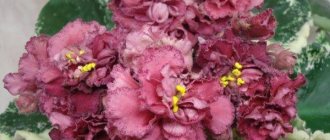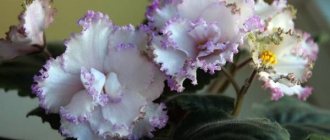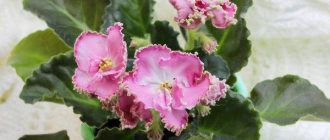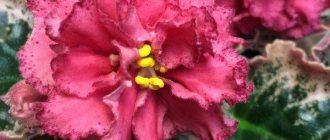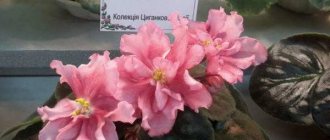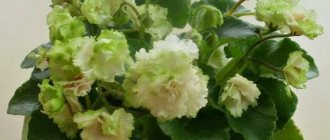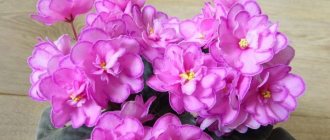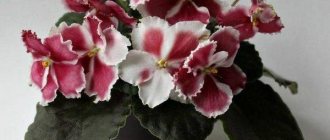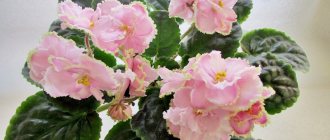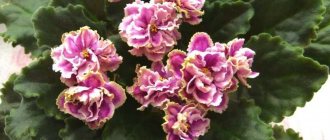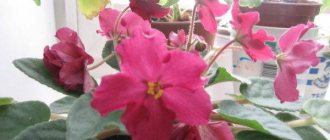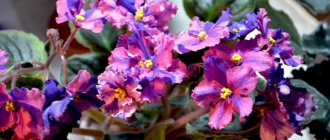It is impossible to imagine any collection of a true lover and connoisseur of flowers without violets. In the modern floristry industry, there are an innumerable number of these flowers, the number of their varieties is constantly growing thanks to the tireless and continuous work of breeders.
We invite you to get acquainted with the magnificent works of the collector and great lover of violets Tatyana Lvovna Dadoyan.
Briefly about the breeder
Tatyana Lvovna Dadoyan is a Russian violet breeder. Tatyana herself can’t stand it when the word “breeder” is applied to her. The activities of this woman remained secret for a long time. She was engaged in breeding new varieties of violets exclusively for herself; this activity was a simple hobby for her.
She presented about 10 varieties of her violets to the society. These plants seem truly perfect. They are endowed with incredible colors and shades, they are characterized by a chic shape of buds and flowers. And their abundant and long-lasting flowering can captivate a true connoisseur.
The most popular varieties and their photos
Dadoyan has been breeding for about 5 years and during this time there are no more than 20 varieties of her selection. But the most commonly heard representatives in the world are the following:
"Water"
The flowers are bright deep blue, double, with dashes or lightened fragments along the edges of the petals of a pinkish tint. Along the edge of the petals there is a green ruffled border. The leaves are dark, quilted with a slightly wavy edge. Sometimes the leaves have red spots on the white backside. The violet grows quickly, the buds blooming very slowly, but simultaneously.
"Grinya"
The flowers are large, fluffy, semi-double and double, white with a thick ruffled green ruffle along the edge of the petals. The leaves are regular, lanceolate, slightly pubescent. It blooms with a magnificent bouquet, abundant flowering.
"Droplet"
This is a plant with large, semi-double, white flowers with wavy edges of the petals. Each flower has a distinct purple eye in the center of the bud. The leaves are elongated, light green in color.
The rosette is neat at the root. The plant blooms quickly, blooms profusely and for a long time.
"Maria"
Curly sport from the Fairy variety. It has large, heavily double pink flowers with a raspberry coating and a green ruffle along the pom-pom flower.
"Snow White"
The flowers are large, in the form of fluffy terry balls of pure white color with wavy edges of the petals. The leaves of the violet are glossy, wavy, bright green. The plant stands out for its abundant bouquet flowering.
"Wild Cherry"
The flowers of the plant are large, semi-double, bright cherry color with a clear, wide white border. Externally, the flower can be compared to a multi-pointed three-dimensional star. The leaves are dark green, spoon-shaped, lanceolate. Wild cherry is a sport from the Frosty Cherry variety.
"Running on the waves"
The flowers are huge, double, variable white with dark blue fragments interspersed. The leaves are regular, dark green. The rosette is neat at the root. The plant blooms quickly, blooms profusely and for a long time.
"Georgia"
The flowers are large, double, bright pink with a crimson border, the edges of the border are decorated with a thick, corrugated green ruffle. Strong peduncles, curly basal rosette.
The leaves are regular, slightly pubescent. Georgia contains a lot of buds on the bush, the flowering period is short.
"Poet Yuri Gal"
This is a soft pink, “porcelain” violet, it got its name in honor of the poet Gal, whose prisoner Tatyana’s father once saved in Stalin’s camps. Then Dadoyan had one goal - to save, survive and joy will come.
Display of life phases
The seedling is characterized by the occurrence of all the main life processes in rhythmic accordance with the flow of similar phases of most varieties of the genus Saintpaulia.
At the same time, the process of creating a comfortable microclimate for a tropical beauty is greatly simplified for flower growers, since care regimes can be built and calculated according to a general model, taking into account individual nuances.
Specifics of room development
The seedling, along with its spectacular decorative appearance, is distinguished by:
- Problem-free character;
- And it does not require flower growers to create complicated conditions for its growth.
This makes the violet ideal for the collections of those new to the cultivation and distribution of Saintpaulias.
Among the positive properties of the seedling are :
- The ability to independently assemble an excellent decorative outlet;
- Rapid growth and harmonious development of a compact outlet;
- Gorgeous flowering in large volumes with frequently repeating waves of buds;
- Significant diameter of flowers with original texture;
- Rare formation of color variations and resistance to changes in regimes;
- Willing propagation using leaf cuttings, in most cases maintaining the color scheme.
INTERESTING! The seedling turned out to be quite dependent on changes in temperature in the room - the richest colors of its flowers are observed in a hot microclimate; in cool conditions, flowering can be accompanied by a decrease in color intensity, the disappearance of pea spots and discoloration of the corollas up to a white color.
Like all violets, the seedling has specific developmental features :
- Explicit temperature dependence, which affects the decorativeness of the seedling;
- The color intensity of flowers gradually increases, reaching a maximum by the third flowering;
- Preferred location on window sills – love for natural light;
- Wavy configuration of leaves, giving volume to the rosette;
- The simultaneous presence of corollas of double and simple structure during flowering.
Formation of an adult specimen
The process of passing through the maturation phase of a seedling approximately corresponds to the general rules and timing for the Saintpaulia genus, depending on the method chosen for obtaining young specimens.
If, to begin the formation of a violet, you take a baby from a leaf cutting, then the first flowering can occur eight months from the moment the embryo of the future baby is laid - the appearance of flowers coincides with the end of the teenage phase and the entry of the violet into adulthood.
ATTENTION! If the basis is a grown-up stepson from the mother’s violet, then the time for growing up will be significantly reduced.
Peculiarity of reproduction
To obtain young specimens of seedlings, it is enough to use one of the possible vegetative propagation methods, but it is preferable to form violets from children planted on specially selected and prepared leaf cuttings. The seedling is capable of producing such children in large quantities.
The seedling can just as easily be propagated by stepsons, carefully separated from the adult violet and rooted in water or directly in a pot with substrate.
CAREFULLY! It is not recommended to use the seed propagation method for seedlings, since there is a high risk of losing all its characteristic distinctive features.
But in the case of rejuvenation of an adult violet, all the qualities of the seedling are always fully preserved .
Effect of heat on seedling flowers
The seedling, like almost all Saintpaulias of K. Morev, depends on changes in temperature . Flowers on a violet that blooms when the thermometer is cool have:
- Quite weak tinting of shades;
- Pale "peas";
- Or the complete predominance of white color.
In a hot microclimate, the seedling fully displays its decorative qualities - its finger coloring is maximally intense, and the radiance of the peas gives the seedling its magnificent appearance.
Violet flowers and buds are extremely feared:
- Temperature changes;
- And drafts.
Therefore, in indoor culture, tropical beauties should be protected from these negative factors.
Pedicel structure
A distinctive feature of a seedling is the formation, from the moment of the first bud formation, of a large number of very strong and shortened peduncles , the strength of which is sufficient to maintain the voluminous bouquets of the seedling in an upright position throughout the long period of their flowering.
Flowering type
By the third flowering, the seedling is capable of forming large volumes of cap-type flowers from large and showy flowers.
Lifespan of a flower
The presented violet blooms for almost two months.
Waves of seedling flowering last almost two months , and each individual flower is able to maintain a fresh decorative appearance for about four weeks.
Description of the best varieties
Most often the names of three violets of Tatiana's selection come up. What do these unique flowers look like?
Plant selection 2010. Appearance:
- the flowers are large, double, white with a pink tint in the center, they have a gorgeous pink wavy edge, which is highlighted by fuchsia dots;
- the flower stalks of the plant are dense and strong;
- the socket is smooth and compact;
- leaves are straight, regular in shape, quilted, wavy along the edge, dark green, glossy;
- the stem is short, emerging from a basal leaf rosette;
- each flower has its own pedicel;
- pedicels slightly pubescent.
- when the flower just opens, it is pure white, the pink border appears over time;
- violet loves a lot of light;
- sometimes a sport plant grows - this is a modified flower, the border does not appear, pink stains appear slightly on the double bud;
- the plant grows slowly.
Violet SM-Miracle Pea (Seedling Morev)
Beautiful violet Miracle Pea.
A fabulous violet with an exotic shape and a unique color scheme of corollas was the result of varietal experiments by the Moscow master to create masterpieces of the Saintpaulia family, Konstantin Lvovich Morev, who learned the basics of the school of selection under the strict guidance of the master in this field of knowledge B. M. Makuni.
Distinctive features
Tatyana Dadoyan is working on the discovery of new species of Uzambara violets. The flowers of the breeder Dadoyan have a number of distinctive features:
- In almost all varieties, the shape of the leaves is regular, spoon-shaped, the leaf edges are smooth (less often jagged or wavy);
- leaves are lanceolate, glossy with slight pubescence;
- Dadoyan violets love a lot of light;
- all flowers in all varieties are in the form of terry pompoms;
- the leaves of all varieties of Uzambara violets emerge from one point, all of them are collected in a basal rosette;
- The flowering of violets is abundant and long, the majority of varieties are characterized by slow opening of buds;
- Violets bloom in a bouquet, each flower has its own separate miniature pubescent peduncle.
Online store "PoTsvety"
Our store presents indoor flowers of different types and varieties from a private collection. From us you can purchase both adult flowering plants and planting material: leaf cuttings, children, tubers, etc. All plants are adapted to indoor conditions. Twice a year the entire collection undergoes comprehensive preventative pest control. The collection has been collected since 2010 and is constantly updated with new exclusive varieties of beautifully flowering indoor plants.
You can place an order in any way convenient for you: directly through the store by creating a basket; by phone 8-906-854-07-75 (WhatsApp, Viber); via email (in a message or text of the letter, write the names of plant varieties and specify in what form you would like to purchase them (baby, cuttings, tuber, etc.)
An invoice for payment is issued after the order has been processed and some details have been agreed upon with you.
After receiving your order using any of the above methods, we will contact you by phone or email.
About the breeder
Tatyana Lvovna Dadoyan is a Russian breeder . Tatyana herself cannot stand it when the word “breeder” is applied to her. The activities of this woman remained secret for a long time.
She was engaged in breeding new varieties of violets exclusively for herself; this activity was a hobby for her. Dadoyan released her plants to people in 2012, when she heard that all combination options in the selection of Uzambara violets had already been sorted out and there could be no new discoveries.
The most popular varieties
Dadoyan worked with violets for about 5 years and during this time there are no more than 20 varieties of her selection. The most commonly heard varieties are :
Georgia - violet flowers are large, double, bright pink in color with a crimson border-spray, the edges of the border are decorated with a thick, corrugated green ruffle. Strong peduncles, curly basal rosette. The leaves are regular, slightly pubescent. Georgia contains a lot of buds on the bush, the flowering period is short.- Maria is a beautiful curly sport from the Fairy variety. It has large, heavily double pink flowers with a raspberry coating and a green ruffle along the pom-pom flower.
- Aquatic - flowers are bright deep blue, double, with streaks or lightened fragments along the edges of the petals of a pinkish tint. Along the edge of the petals there is a green ruffled border. The leaves are dark, quilted with a slightly wavy edge. Sometimes the leaves have red spots on the white backside. The violet grows quickly, the buds blooming very slowly, but simultaneously.
- Snow White - the flowers of the plant are large, in the form of fluffy terry balls of pure white color with wavy edges of the petals. The leaves of the violet are glossy, wavy, bright green. The plant stands out for its abundant bouquet flowering.
- Grinya - flowers are large, fluffy, semi-double and double, white with a thick corrugated green ruffle along the edge of the petals. The leaves are regular, lanceolate, slightly pubescent. It blooms with a magnificent bouquet, abundant flowering.
- Droplet is a plant with large, semi-double, white flowers with wavy edges of the petals. Each flower has a distinct purple eye in the center of the bud. The leaves are elongated, light green in color. The rosette is neat at the root. The plant blooms quickly, blooms profusely and for a long time.
- Wild cherry - the flowers of the plant are large, semi-double, bright cherry color with a clear, wide white border. Externally, the flower can be compared to a multi-pointed three-dimensional star. The leaves are dark green, spoon-shaped, lanceolate. Wild cherry is a sport from the Frosty Cherry variety.
- Running on the waves - the flowers are huge, double, variable white with dark blue fragments interspersed. The leaves are regular, dark green. The rosette is neat at the root. The plant blooms quickly, blooms profusely and for a long time.
- The poet Yuri Gal is a soft pink, “porcelain” violet; it got its name in honor of the poet Gal, whose prisoner Tatyana’s father once saved in Stalin’s camps. Then Dadoyan had one goal - to save, survive and joy will come. This plant is capricious; if not properly cared for, it quickly dies, but its goal is also to survive and give joy.
Recommendations for selection
When choosing a particular variety, it is worth asking about the predisposition to diseases and the presence of resistance to low temperatures. Each type has its own irreplaceable qualities. Some varieties are especially capricious, so they are not easy to grow for novice plant growers. Thanks to the art of selection, today there are about 2 thousand hybrids. Among the representatives of blue color you can find flowers with star-shaped buds, classical or even limbic shape.
All violets can be divided into “girls” and “boys”; you can simply recognize them by their foliage. If there is a bright spot at the base, then it is a girl. You can find plants with a large rosette or a miniature one; which one to choose depends on the person’s preferences. When purchasing, the first thing the grower needs to pay attention to is the absence of spots on the leaves or spaces between them. All this suggests that the violet is infected. If the bush is very elongated, it means that it was kept in conditions where it did not have enough sun, so it is not clear whether the roots under the ground are healthy.
The name and variety must be indicated on each pot; you can compare it on the Internet with a picture if you don’t want to be deceived.
Description of the best views and photos
Most often, the names of three violets of Tatyana’s selection come up among flower growers. What are they, these magnificent flowers?
"Fairy Dadoyan"
Plant selection 2010. Appearance :
- the flowers are large, double, white with a pink tint in the center, they have a gorgeous pink wavy edge, which is highlighted by fuchsia dots;
- the flower stalks of the plant are dense and strong;
- the socket is smooth and compact;
- leaves are straight, regular in shape, quilted, wavy along the edge, dark green, glossy;
- the stem is short, emerging from a basal leaf rosette;
- each flower has its own pedicel;
- pedicels slightly pubescent.
Peculiarities:
- When the flower first opens, it is pure white, with a pink border appearing over time.
- Violet loves a lot of light.
- Sometimes a sport plant grows - this is a modified flower, the border does not appear, pink stains appear slightly on the terry bud.
- The plant is not early ripening and grows slowly.
"Raspberries"
Plant selection 2011. Appearance :
- the flowers are large, double, like a pompom, bright crimson, the edges of the petals are wavy;
- leaves are regular, spoon-shaped, dark green, lanceolate, glossy, slightly pubescent;
- stems are short, pubescent, emerging from a basal rosette;
- the socket is compact, but folds out well;
- one stem may have several pedicels (inflorescence umbrella);
- peduncles erect, buds heavy.
Peculiarities:
- During the flowering period, the flowers bloom slowly but amicably.
- The plant requires a sufficient amount of light, but does not tolerate active exposure to the sun.
- The buds can tilt the peduncle, this can lead to creases and death of the flower.
"Marquise"
Plant selection 2011. Appearance :
- the flowers are large, double, bright pink with a crimson edge and a thin white edge and a wave along the edge;
- leaves are dark, glossy with a slight edge;
- the shape of the leaves is regular, spoon-shaped, the leaf edges are smooth;
- pedicels-stalks emerge from the basal rosette;
- the flower stalks of the plant are dense and strong;
- the socket is smooth and compact;
- the pedicels are pubescent.
Peculiarities:
- The awning is demanding in terms of lighting, does not tolerate the aggression of the sun, but also does not like constant shadow; on cloudy days, additional illumination with a photo lamp is required, and in extreme heat, shading of the plant is necessary.
- Young seedlings quickly and actively grow foliage.
- The variety develops quickly and blooms early.
Next you can watch a video review of this variety:
Contents in room culture
The seedling is not a “capricious” variety and responds favorably to careful and regular implementation of simple care regimens that are used for a large number of representatives of the Saintpaulia genus :
- Placement of the seedling is shown on the western or eastern window; windows facing north need additional equipment with artificial light, and when the window faces south, artificial shade is needed for the plant;
- It is better to water in moderate doses, after a slight degree of drying for the upper tier of the substrate;
- About the need to make additional mineral supplements the florist will promptly tell the condition of the violet;
The variety requires proper care. - Lighting should be created natural, long-lasting and diffused spectrum;
- the temperature within +20 + 24°C without sudden fluctuations;
- Fill the flowerpots with nutritious soil with good aeration and water permeability; volumetric drainage is required;
- When transferring, give preference to receiving transshipment, except in unforeseen cases;
- to increase the air humidity in the room in any acceptable way, except for direct spraying of violets.
Distinctive features of flowers
Its flowers have a number of distinctive features:
- all flowers in all varieties are in the form of terry pompoms;
- the leaves of all varieties of Uzambara violets emerge from one point, all of them are collected in a basal rosette;
- In almost all varieties, the shape of the leaves is regular, spoon-shaped, the leaf edges are smooth (less often jagged or wavy);
- leaves are lanceolate, glossy with slight pubescence;
- Dadoyan violets love a lot of light;
- The flowering of violets is abundant and long, the majority of varieties are characterized by slow opening of buds;
- Violets bloom in a bouquet, each flower has its own separate miniature pubescent peduncle.
The species and varieties of violets considered by this breeder are true works of floristic art. Terry Dadoyan's terry violets will bring bright colors to any home and dilute your gray everyday life with their beauty.
If you find an error, please select a piece of text and press Ctrl+Enter.
- Author: Maria Sukhorukikh
Rate this article:
- 5
- 4
- 3
- 2
- 1
(0 votes, average: 0 out of 5)
Share with your friends!
Transfer
It is necessary to replant the Fairy as the rosette grows. To do this, you can buy the substrate in the store or prepare it yourself.
The soil mixture should consist of:
- 2 parts of turf;
- 1 part peat;
- 2 parts leaf soil;
- 1 part pine litter;
- 1 part vermiculite.
The pot for planting is also important; its diameter should be 2 cm larger than the previous one.
It is important that drainage holes are made in the bottom, which will prevent moisture stagnation. Then cover it with a layer of soil
After this, remove the violet without disturbing the earthen lump
Then sprinkle it with a layer of earth. After this, remove the violet without disturbing the earthen lump.
Place it in the center and fill the resulting voids with earth. The plant needs to be deepened to the first leaves. After this, the violet must be watered.
